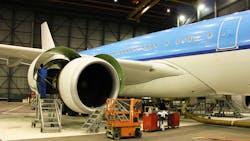Reflection on Inspection: How to Prepare and Why Record Keeping is Crucial
Key Highlights
- Receiving inspections are distinct from maintenance activities and involve verifying business information before the article undergoes preliminary inspection.
- Repair stations must establish procedures for incoming inspections, final inspections, and maintaining records to ensure compliance with key regulations.
- Personnel training and understanding of regulatory requirements are essential to prevent non-compliance and ensure aviation safety.
In May, an ARSA member asked whether use of a surface scanning machine constitutes a step in the maintenance process and therefore must be performed by a qualified inspector.
The association concluded that the creation of a scan is not maintenance, basing this decision on several factors, such as:
- The regulatory definition of “maintenance”
- A review of supporting guidance
- Several back-and-forth exchanges with the member
- Research determining that pilots of drones used to perform airframe inspections are not considered inspectors, as the drones are autonomous
As always, the regulatory analysis associated with that determination is instructive.
What to consider when planning and performing inspections
According to §145.211, a repair station’s quality system requires a description of procedures for performing preliminary inspection and final inspection before issuing an approval for return to service of maintained articles.
If an article has been involved in an accident, (§145.211(c)(1)(iii) covers hidden damage inspections. The system must also describe how the repair station establishes and maintains proficiency of the responsible inspection personnel.
A repair station’s quality system also requires a description of procedures for incoming inspections of raw materials.
A 2017 FAA legal interpretation to ARSA about receiving inspections determined they do not constitute maintenance activities.
Though the interpretation addresses questions of a “safety sensitive function” for drug and alcohol testing purposes under Part 120, it notes: “14 CFR part 43 applies to the performance of maintenance and preventative maintenance.
How does record keeping factor in?
Sections 43.9 and 43.11 establish recordkeeping requirements for tasks associated with maintenance and preventative maintenance. These recordkeeping requirements have never been applied to tasks associated with receiving articles for stock.
All items received for work under the authority of a repair station certificate must undergo a preliminary inspection. The purpose of having procedures around that requirement is to ensure the work requested can be reconciled with what’s required in a technical sense.
That inspection must be performed by a qualified inspector; however, before the work is accepted for processing, business information must be obtained, such as:
- Customer
- Part number
- Serial number
- Extent of work requested
- Payment information
The “receiving” process only prepares the article for the preliminary inspection.
Though the quality system section lists final inspection and return to service in the same subparagraph. The two are separated by the operating rules in (§145.213(a), which requires the repair station “inspect each article upon which it has performed maintenance, preventive maintenance, or alterations…before approving that article for return to service.”
§145.213(b) stipulates that after an inspection, the repair station must certify on the maintenance release that the article is airworthy with respect to the work performed. The repair station is also required to provide a copy of that maintenance release to the owner or operator of the article on which the work was performed and to maintain for at least two years its records demonstrating compliance with Part 43.
How to consider regulatory compliance and aviation safety regarding inspections
Repair station requirements related to inspections are spread throughout part 145. As with any regulatory activity, personnel required to comply must understand this lattice work of regulations, their applicability and the expectations placed upon individuals holding specific responsibilities under the rules.
Similarly, there must be an understanding of when aviation safety is involved and when business practices apply. In the member’s case, the person performing the receiving process is to utilize the scanner so the result can be reviewed by the person performing the preliminary inspection.
The receiving process is not considered maintenance; it merely sets up the article for acceptance by the repair station and readies it for preliminary inspection.
To ensure you're adequately prepared, consider these questions:
- How do your receiving practices relate to preliminary inspection?
- Do business requirements—like ensuring the customer’s bona fides—overlap with regulatory reference like confirming a request against a capability list?
- Who performs this work and how are they trained?
Walking through—and training yourself on—the rule requirements ensures you don’t get snared in the “lattice” of requirements. Doing so allows you to answer questions, stay compliant and keep out of trouble.
About the Author
Brett Levanto
Brett Levanto is vice president of operations of Obadal, Filler, MacLeod & Klein, P.L.C. managing firm and client communications in conjunction with regulatory and legislative policy initiatives. He provides strategic and logistical support for the Aeronautical Repair Station Association.

